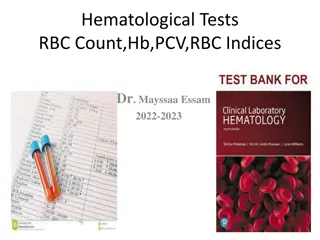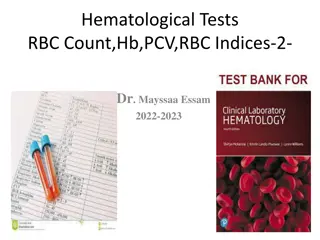Hemoglobin Estimation Using Sahli Method
Hemoglobin estimation using the Sahli method involves converting measured blood samples to acid hematin, which is then matched against colored glass rods for color intensity assessment. Normal values for males and females are provided, along with potential sources of error and conditions leading to increased or decreased hemoglobin levels. The apparatus and materials necessary for conducting the Sahli method are also listed.
Download Presentation

Please find below an Image/Link to download the presentation.
The content on the website is provided AS IS for your information and personal use only. It may not be sold, licensed, or shared on other websites without obtaining consent from the author.If you encounter any issues during the download, it is possible that the publisher has removed the file from their server.
You are allowed to download the files provided on this website for personal or commercial use, subject to the condition that they are used lawfully. All files are the property of their respective owners.
The content on the website is provided AS IS for your information and personal use only. It may not be sold, licensed, or shared on other websites without obtaining consent from the author.
E N D
Presentation Transcript
Estimation of Estimation of Hemoglobin Hemoglobin Sahli Sahli method method
Principle 1. The Hb present in a measured amount of blood is converted by dilute hydrochloric acid into acid hematin, which in dilution is golden brown in color. 2. The intensity of color depends on the concentration of acid hematin which, in turn, depends on the concentration of Hb.
Principle 3. The color of the solution, after dilution with water, is matched against golden brown tinted glass rods by direct vision. 4. The readings are obtained in g%.
Normal values The average levels and their ranges are as follows: Males: (13.5 18) g/dl, (14.5 g/dl). Females: (11.5 16) g/dl, (12.5 g/dl).
Increased Hb 1. Experimental error Blood taken more than 20 l or blood sticking to the outside of the pipette tip. Fading of colored glass standards (rods).
Increased Hb 2. High red cell count Physiological: newborns, high altitude, etc. Pathological: polycythemia/hypoxia due to heart or lung diseases.
Decreased Hb 1. Experimental error Blood sample diluted with tissue fluid. Blood taken is less than 20 l. Color of acid hematin not allowed to develop fully.
Decreased Hb 2. Decreased red cell count Physiological: females during pregnancy (hemodilution). Pathological: all cases of anemia.
Apparatus and materials I. Sahli Hemoglobinometer (Hemometer). II. Decinormal hydrochloric acid solution (0.1 N HCl). III. Materials for skin prick. Sterile lancet/needle Sterile gauze and cotton swabs Methylated spirit/70% alcohol
Sahli Hemoglobinometer 1. Comparator It is a rectangular plastic box with a slot in the middle which accommodates the calibrated Hb tube. Non-fading, standardized, golden-brown glass rods are fitted on each side of the slot for matching the color. An opaque white glass is fitted behind the slot to provide uniform illumination during direct visual color matching.
Sahli Hemoglobinometer 2. Hemoglobin tube The square or round glass tube is calibrated in g Hb % (2 22 g%) on one side, and in percentage Hb (10 140 %) on the other side.
Sahli Hemoglobinometer 3. Hemoglobin pipette It is a glass capillary pipette with only a single calibration mark 0.02 ml (20 l ). There is no bulb in this pipette (as compared to cell pipettes) as no dilution of blood is done.
gm% % 22 140 20 130 18 120 110 16 100 14 90 20 cmm 20 l 12 80 70 10 60 8 50 6 40 4 30 20 2 Hemoglobin tube Hemoglobin pipette 10
Sahli Hemoglobinometer 4. Stirrer It is a thin glass rod with a flattened end which is used for stirring and mixing the blood and dilute acid. 5. Pasteur pipette It is a 8 10 inch glass tube drawn to a long thin nozzle, and has a rubber teat.
Procedure 1. Using a glass dropper, place 8 10 drops of N/10 HCl in the Hb tube, or up to the mark 20%.
Procedure 2. Get a finger prick under aseptic conditions, wipe away the first 2 drops of blood. When a large drop of free-flowing blood has formed again, draw blood up to the 20 l mark (0.02 ml). Carefully wipe the blood sticking to the tip of the pipette with a cotton swab.
Procedure 3. Without any waiting, immerse the tip of the pipette to the bottom of the acid solution and expel the blood gently. Rinse the pipette 3 4 times by drawing up and blowing out the clear upper part of the acid solution till all the blood has been washed out from it. Avoid frothing of the mixture. Note the time.
Procedure 4. Withdraw the pipette from the tube, touching it to the side of the tube, thus ensuring that no mixture is carried out of the tube. Mix the blood with the acid solution with the flat end of the stirrer by rotating and gently moving it up and down.
Procedure 5. Put the Hb tube back in the comparator and let it stand for 6 8 minutes. During this time, the acid ruptures the red cells, releasing their Hb into the solution (hemolysis). The acid acts on the Hb and converts it into acid hematin which is deep golden brown in color. The color of acid hematin does not develop fully immediately, but its intensity increases with time.
Procedure 6. Diluting and matching the color Dilute the acid hematin solution with distilled water till its color matches the color of the standard tinted glass rods in the comparator.
Procedure 7. Take the Hb tube out of the comparator and add distilled water drop by drop, stirring the mixture each time and comparing the color with the standard. 8. Hold the comparator at eye level, against bright but diffused light. Read the lower meniscus (lower meniscus is read in colored transparent solutions).
Sources of error 1. Technical error Due to; not taking exactly 20 l blood, or not giving enough time for formation of acid hematin, or using an old comparator that has faded glass rods. 2. Personal error Since it is a visual method, color matching may vary from person to person.
Observations and results Compare your color matching with that of your work partner and record the observations in your workbook. Take the average of 3 readings, and report your result as: Hb = .g/dl.
Observations and results 1st reading, when the color is slightly darker than the standard: .g/dl. 2nd reading, when, after adding a few drops of distilled water, the color exactly matches the standard: g/dl. 3rd reading, when, after adding some more drops, the color becomes a little lighter than the standard: g/dl.
Report Express your result as: Hb= .... .g/dl (not in %). Oxygen carrying capacity Knowing your Hb concentration, and that 1.0 g of Hb can carry 1.34 ml of O2, calculate its oxygen-carrying capacity as . ml O2/dl.
Advantages of Sahli method 1. Simple, fairly quick, and accurate. 2. It does not require any costly apparatus, since it needs only direct color matching. 3. Its running cost is minimal and can, therefore, be used in mass surveys.
Disadvantages of Sahli method 1. Since the acid hematin is not in true solution, some turbidity may occur. 2. The method estimates only the oxyHb and reduced Hb, other forms, such as carboxyHb and metHb are not estimated. 3. The degree of error may be high if proper precautions are not taken.
PRECAUTIONS 1. All precautions mentioned for collecting finger prick blood, and filling the pipette must be observed. 2. The finger should not be squeezed, and there should not be any blood sticking to the outside of the pipette tip.
PRECAUTIONS 3. Only the recommended time should be allowed for the formation of acid hematin by the action of acid on Hb. 4. When diluting the color of acid hematin solution, avoid over-dilution because the color cannot be concentrated.
PRECAUTIONS 5. When matching the color, the solution should be uniformly golden brown throughout the solution. Dark color near the bottom of the tube indicates poor mixing. 6. During color matching, 3 readings should be taken to reduce the personal error.























